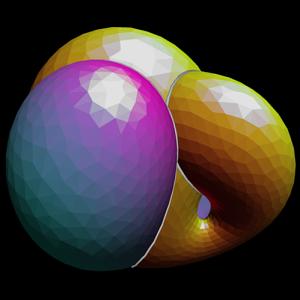
November 9, 2000
In November of 1999, Professor of Mathematics, George Francis contacted me, asking me if I would be interested in making physical sculptures from the Optiverse movie, which Professor Francis, John Sullivan and others had made and shown in 1998.
The Optiverse shows an entirely new way to turn a sphere inside out without cutting it. This operation is called eversion.
The Optiverse is in part based on another sphere eversion developed by Bernard Morin.
One difference between the Optiverse and Morin's eversion is that the Optiverse uses a minimal surface bending energy constraint, imposed by simulating the surface in Ken Brakke's Evolver.
Bernard Morin is a mathematician, blind since childhood, former Fellow at the Institute for Advanced Study, Princeton University.
Professor Morin was interested in the ways in which the Optiverse differs from his Morin eversion, but he could not understand the difference, because he could not see the computer-rendered Optiverse movie.
I created four eight-inch models from frames 0, 9, 12 1nd 27 of a 54-frame clip of the computer-generated geometrical data from the Optiverse. The objects were built courtesy of 3-D Systems, Santa Clarita, California.
I presented these models to Professor Morin during an International Colloquium on Art and Mathematics in Maubeuge, Northern France on September 22, 2000.